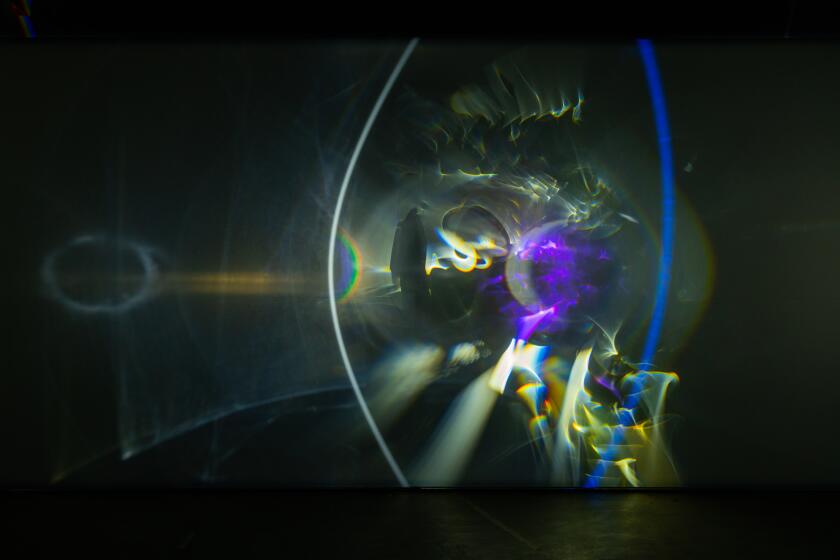Wacky Grand Ave., Broad museum or no
After dangling his collection of modern art before a couple of other cities, billionaire Eli Broad is now toying with the idea of housing it in a new museum on Grand Avenue, across from the Walt Disney Concert Hall.
Broad, who has become quite the public tease, is being criticized for asking the county to lease him the land for $1 per year.
I don’t have strong feelings about the propriety of his proposal. Grand Avenue wouldn’t be what it is today — however imperfect — without generous public subsidies.
But Broad went too far when he divulged to an interviewer some time back his vision of Grand Avenue as the Champs-Elysees of Los Angeles.
As a lifetime inhabitant of this city, and the husband of a Frenchwoman to boot, I think I’m qualified to say that Los Angeles does not have and never will have a Champs-Elysees. Nor should it want one.
The national hubris embodied in that eight-lane avenue, the palaces of kings, the monuments from antiquity, the indelible images of victory and defeat, even the no-holds-barred traffic, are things we love about Paris, not L.A.
I have no doubt Broad too has promenaded on the Champs-Elysees and knows what it would take to replicate even a fraction of its grandeur.
Take just the Place de l’Ėtoile, the humungous traffic circle that spins cars arriving from 12 radiating streets in a mad dash around the Arc de Triomphe, the monument built by Napoleon Bonaparte to commemorate his military might and later used as a symbol of victory by armies marching east and west, including America’s.
What kind of equivalent monument could L.A. hope for? Perhaps Saddam Hussein’s “crossed swords” are for sale? I’ve walked under them myself, and I can say that they certainly catch the spirit of Napoleon’s famous arch.
Then maybe we could bring the London Bridge back from the desert to mark the other end of the avenue, like the 3,300-year-old Egyptian obelisk that stands in the Place de la Concorde.
I only offer these ridiculous props to illustrate how overwhelmed our stubby, narrow Grand Avenue would be by the architectural scale that makes the Champs-Elysees the world’s most recognizable street.
To match the scale in an L.A. equivalent, Caltrans would have to dedicate the Santa Monica Freeway from Overland Avenue to the 405 Interchange.
L.A. could use a place where tens of thousands could congregate each night in public revelry and celebration of their heritage, as Parisians do on the Champs-Elysees. But despite any vision of Broad’s, that place won’t be Grand Avenue, a street that reflects, more than anything, L.A.’s unimaginative leadership.
It’s been decades since the Community Redevelopment Agency removed the Victorian homes atop Bunker Hill that gave Grand Avenue its name. And what do we have besides a currently stalled high-rise condo and shopping center project?
The avenue has assumed an air of spotty elitism and architectural pomposity that at least has the grace of being as wackily mismatched as the rest of Los Angeles.
There are some high-rise boxes, a food court, the ugliest courthouse and county administrative complex west of the Mississippi, a big-boned music hall, an inscrutable statue — my father, who loved L.A. with all its rough edges, called it the “hideous monstrosity” — a dull cathedral that has its best side facing the Hollywood Freeway and an arts high school with a tower that looks like a waterslide.
Broad and I haven’t spoken since I took him to task a few years ago for his backroom maneuvering that added the $6-million tower to the high school at taxpayer expense. But then, we didn’t speak often before that.
To be fair, the high school represents a positive step, as did the Museum of Contemporary Art when it moved (with Broad’s financial support) to its permanent home on Grand Avenue in 1986. And those are not even Broad’s primary contributions to Grand Avenue. That would be Disney Hall, with its hallucinogenic form that has become to the city’s most recognizable building. Broad personally deserves much of the credit for seeing through the one addition that actually puts Grand Avenue on the world stage.
But for many Angelenos, the visage of Disney Hall is pretty much blocked by that rusting, Erector-set of a parking structure that stands across the street on a weed-infested lot.
Unfortunately, Broad’s museum wouldn’t take the place of the parking structure. But given the visual cacophony that marks Grand Avenue today, and the absence of any wide attractions, I think Broad’s enterprise could only be an asset, no matter how far short it falls of his personal vision for a truly grand avenue.
I hope he gets his deal, and I hope too that in planning his museum, he gets in sync with the one Grand Avenue institution that lifts my sprit, the little-noticed Colburn School. It’s quiet, sophisticated and, unlike all the other public buildings around it, welcoming to passersby who can gawk at the whimsical mobile by L.A. artist Peter Shire hanging in its lobby and listen to some of the city’s promising young musicians practice.
If Broad’s museum is inviting enough, I might even drop by to try to understand the art. Generally, I find modern art hard to connect with. My taste was nurtured in a house my father lovingly described as “Early Akron” — after the erstwhile import emporium, not the city in Ohio.
Bumpkin though I may be, I know when I’m being conned. So please, Eli, don’t try to beguile us with conceits. Give us a museum worthy of your name. And let’s all agree:
When it’s done, Grand Avenue will still be a jumble of beauty, banality and blight, and the Champs-Elysees will still be the world’s most magnificent street.
More to Read
The biggest entertainment stories
Get our big stories about Hollywood, film, television, music, arts, culture and more right in your inbox as soon as they publish.
You may occasionally receive promotional content from the Los Angeles Times.











